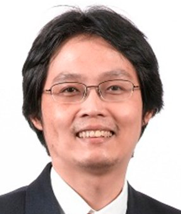Dr. Lay Kee (Ricky) Ang
Singapore University of Technology and Design
Lectures
Electron Emission Models for Two-Dimensional Novel Materials
Electron emission from a material through an interface to vacuum or other materials is a fundamental process in cathodes, diodes, ionization and electrical contact. Depending on the energy used to produce electron emission, it can be broadly characterized into 3 processes: thermionic emission TE (thermal energy), field emission FE (quantum tunneling) and photoemission PE (photon absorption). Basic models for these processes (TE, FE, PE) have been captured in the Richardson-Dushman (RD) law, Fowler-Nordheim (FN) law, and the Fowler-Dubridge (FD) law. With the development of two-dimensional (2D) atomic scale materials, these classical laws will require revision to account for the new material properties. In this talk, self-consistent electron emission models will be presented to report new scaling laws, which shows smooth transition to the classical models. Comparison with recent experimental results, and their applications in cathodes, electronics, and photonics will be discussed.
Space Charge Limited Current Models
Space-charge-limited (SCL) electron flow describes the maximum current density allowed to be transported across a diode with an applied voltage. The first SCL current model was formulated more than 100 years, which is widely known as the Child-Langmuir (CL) law. Similarly, for high current transport in solids (like dielectrics and organic materials), the space charge effect of the injected current is also important, and the corresponding SCL model for a trap-free solid is known as the Mott-Gurney (MG) law. In this talk, we will report the revision of the CL law and MG law to account for new effects in quantum regime, ultrafast time scale, finite emission area, roughness, and also new materials. We will also show the new scaling laws and their smooth transition between the new and the traditional models. The relationship between the CL law and MG law will also be demonstrated. Applications of the models in high current cathodes and organic electronics will be discussed.
Ultrafast Laser Induced Electron Emission Models
The generalized Einstein’s photoelectric effect (known as multiphoton electron emission) predicts that the number of photons (required for electron emission) is an integer equal to the number of quanta that can overcome the work function. This effect is characterized by the Keldysh parameter (much larger than 1) at lower laser field strength. In the other limit (much lower than 1) at high laser field, electron emission is due to time-dependent tunneling, also known as optical tunneling. In this talk, we will present a generalized model that is able to consistently link these two regimes including the non-equilibrium heating of the metals, which is important at sub-100 femtosecond time scale. Using this new model, we report useful scaling law at the transition between the two regimes, and also the time-dependent characteristics of the emitted ultrafast electron pulse in the adiabatic tunneling regime (Keldysh parameter on the order of 1). Applications and comparisons of our models with some key experimental works from other groups will be discussed.
Some Applications on Fractional Modelling in Physics and Engineering
In modelling or simulation, it is common to solve coupled differential equations in one-, two- or three- dimensions (1D, 2D, or 3D) with corresponding boundary conditions. For complicated objects, the dimension may not be strictly 1D, 2D or 3D, where the normal computational approach may be expensive as it will involve multiple scale computation. By using fractional models developed mathematicians, a complicated object is projected into a “fractional” dimension in order to solve the relevant equations in this non-integer dimension with the assumption that the effects at smaller scales can be ignored. In this talk, we will present some recent results of using such “fractional” models on problems such as fractional high current from rough cathode, fractional high current transport in organic diode, fractional tunneling law, fractional Fresnel coefficients for laser absorption, fractional capacitor, and others. These new fractional models will provide useful fractional parameters that can be characterized by experimental measurements. The calculated results will be compared with available experimental results or normal numerical results.
About

Prof. Lay Kee (Ricky) Ang received his BS degree in 1994 from the National Tsing Hua University, Taiwan, and his MS and PhD degrees from the University of Michigan, USA (1996, 1999). He is currently the Ng Teng Fong chair professor in the Singapore University of Technology and Design (SUTD) and also the head of Science and Mathematics. Before joining SUTD, he was with the Nanyang Technological University, Singapore (2002-11), and with Los Alamos National Laboratory as the director postdoctoral fellow (1999-2001). His research interests are in the formulation of basic scaling laws and models in using novel two-dimensional (2D) quantum materials in broad area of electron emission/injection, light-matter interaction, electronics and photonics. He is also interested in using fractional modeling techniques to analyze complicated and disordered objects or systems. His research works are currently funded by Singapore and USA. He was the founding chair of the NPSS chapter in Singapore.